October 14, 2025 • 7 min read
Customer Loyalty Program Optimization: How to Achieve 5.2x ROI

CX Analyst & Thought Leader
October 14, 2025

Customer sentiment is down. Customer acquisition costs are up. Economic uncertainty and inflation have dramatically cooled customer spending. Doom and gloom is at an all-time high in the customer experience discourse.
In spite of all of this, customer loyalty is thriving. 83% of businesses with an existing loyalty program report a positive ROI. Companies that consistently measure their ROI report loyalty programs have generated 5.2 times their initial investment.[*]
Brands cite deeper customer engagement, increased customer spend, and the opportunity to collect valuable customer data as the top benefits of implementing a customer rewards program.
Today, customer loyalty and reward programs aren’t just about customer retention, they’re about generating customer revenue.
Still, shifting customer expectations and priorities surrounding loyalty programs mean continued success is not guaranteed. What does maintaining customer loyalty take now, and what is your existing loyalty program missing?
What Do Customers Want From Loyalty Programs?
TL;DR: Customers are no longer content with physical stamp cards and or a free donut day that comes just once a year. Instead, customer priorities regarding loyalty programs are about up-to-the-minute offers, reward customization and flexibility, account sharing, mobile apps, gamification, and, of course, deeper discounts.

Discounts, Rewards, and Cash Back
It’s not a surprise that customers still value discounts, rewards, and cash back over any other aspect of a loyalty program. 70% of customers say the promise of deals is their biggest reason for joining a loyalty program.[*] But it’s how they want to redeem those rewards that’s changed.
Flexible and Customizable Rewards
Today's customers demand greater control over the value they receive from rewards programs, making flexibility in earning and redeeming points a key differentiator. 40% of customers currently want more flexibility not only with how they spend their rewards, but also in how they earn them. The problem? Less than half of loyalty programs currently offer this flexibility, meaning there’s a significant gap in customer expectations of loyalty programs and experience they’re actually getting.[*]
While they still love earning points on purchases, customers want to be able to earn rewards through referrals, brand mentions on social media, or even by participating in brand-specific events or clubs. Double-point days are especially popular.
When it comes to point redemption, customers want the flexibility to choose their rewards–and 81% would prefer to shop with brands that allow them to do so. Nearly ¾ of customers want to customize the benefits they earn upon reaching a new rewards tier. 25% of customers also want an end to restrictive point expiration dates, citing growing frustration at increasingly complex redemption rules.[*]
Account Sharing and Point Pooling
Given the drop in consumer spending, it makes sense that today’s customers are increasingly interested in being able to pool their rewards with friends and family members. But while 76% of customers are all in on point pooling, only about 44% of companies allow it.[*] To do point and sharing right, businesses should define what constitutes a household or a team and clarify the rules before enrolling new members.
Mobile Apps For Rewards Programs
The modern loyalty experience is increasingly mobile-centric. A strong majority of consumers (59%) prefer to interact with loyalty programs via mobile apps, and 80% would download a mobile app for loyalty programs if one was available.[*] The potential payoff of building a mobile app for your rewards program is huge, as over 40% of consumers say they use loyalty mobile apps at least once a week.[*]
Interestingly, while customers prefer to interact with their rewards via mobile app, the majority still sign up for loyalty programs on a company website, and prefer to receive loyalty program updates via email.
To get loyalty right, brands must prioritize seamless digital experiences, optimize mobile interfaces, and ensure their in-store offerings match the convenience of digital channels.
Timely Alerts and Offers
In spite of what current industry reports would have you believe, impulse buying is still very much alive–at least, when it comes to shopping with points or getting great deals from loyalty programs.
40% of customers now want frequent and real-time alerts about offers–so make sure to send a text blast or push notification when you have a competitive customer reward coming up.[*]
Gamified Earning and Data Sharing
Customers are willing to share their data with businesses–but expect a hyper-personalized and optimized rewards experience in return. They're also cooling on traditional forms of data collection.
Over half of consumers are willing to share personal information with brands that use gamification to collect it. Think interactive quizzes or in-app mood board creation, not filling out online forms. Currently only about 42% of companies with a loyalty program offer gamified data collection–although over 70% of loyalty program owners say gamification is helpful for gathering valuable, high-quality customer data.[*]
Gamification is especially valuable for bridging the customer trust gap. Customers are now less comfortable with sharing personal data with loyalty programs than they were a year ago. However, over half of consumers cite increased product personalization as a top benefit of data sharing. Delivering customized rewards, then, makes customers more likely to continue sharing their data.[*]
How Is AI Transforming Loyalty Programs?
TL;DR: AI makes it possible for businesses to meet evolving customer loyalty program demands at scale. It streamlines personalization, predicts when customers are likely to buy, and optimizes the customer support process. In fact, customers are more receptive to AI-driven loyalty programs than ever, with nearly 40% saying they’d be more interested in rewards programs that use AI to maximize their benefits.

Agentic AI In Loyalty Programs
Agentic AI, designed to autonomously take the best course of action, not just generate ideas, can help businesses plan point allocation adjustments, optimize reward structures, and refine communication strategies/marketing plans. Agentic AI is especially valuable when it comes to loyalty program scoping. This includes defining clear program objectives, proper customer segmentation, and assessing operational readiness.
Hyper-Personalized Rewards and Offers
Roughly ⅓ of customers cite personalized offers and product recommendations as a top motivator to sign up for a rewards program.[*] Businesses can leverage AI to determine the ideal rewards and redemption structure, meeting the increased consumer demand for hyper-personalized loyalty programs.
AI also helps companies ensure they offer these reward and redemption opportunities at the ideal time for the customer: like right after they graduate to a higher rewards tier or when they're at risk of abandoning their online shopping cart.
Customer loyalty program success requires evolving beyond transactional point-earning systems to create truly personalized, flexible, and emotionally resonant customer experiences.
By leveraging AI for hyper-personalization, prioritizing customer control and flexibility, and building intuitive rewards mobile apps, brands can transform their loyalty programs from cost centers into powerful revenue generators and relationship builders.
Predictive Insights and Motivation
In addition to standard hyper-personalization, leveraging AI in loyalty programs allows for the kind of predictive engagement that boosts customer spend and retention. For example, AI could notice that a customer has not yet placed their usual monthly order, then send them a 10% off coupon to encourage a purchase.
AI could eventually access customer data across different platforms and sources to provide an even more holistic customer experience.
Customer Loyalty Programs: Your Brand's Secret Weapon
Long-term customer loyalty requires moving beyond transactional point-earning systems to create truly personalized, flexible, and emotionally resonant experiences.
By leveraging AI for hyper-personalization, prioritizing customer control and flexibility, and ensuring seamless omnichannel integration, brands can transform their loyalty programs from cost centers into powerful revenue generators and relationship builders.